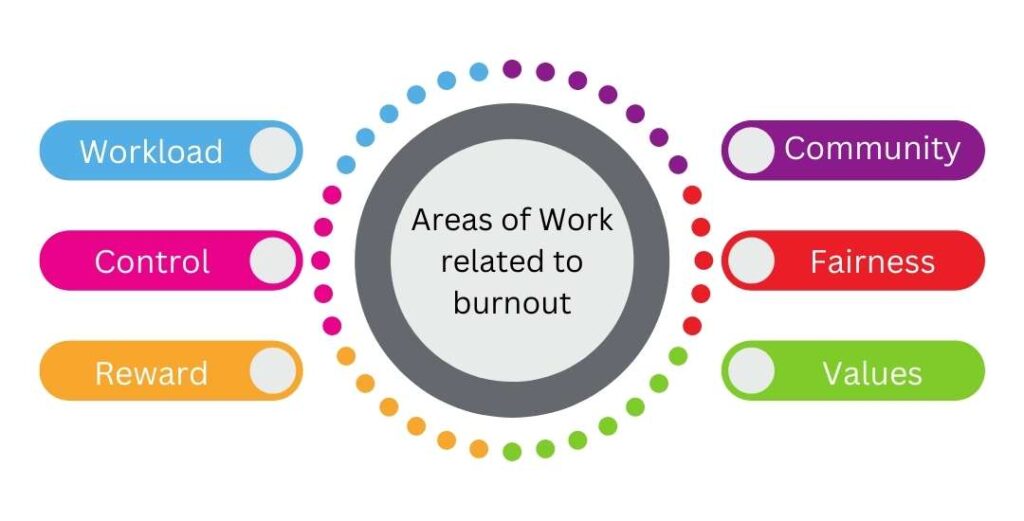If you are recognising signs of burnout such as: chronic exhaustion; feeling detached and negative about work; not functioning well at work, or constantly doubting your abilities, it’s important to take action.
But how do you know what action to take? The right thing to do will vary depending on what form burnout is taking for you, and what the causes are.
My Burnout Toolkit can help you figure out how burnout is impacting you and offers psychological strategies for coping. This article takes a closer look at underlying causes of burnout, and how to tackle those.
There are 6 key causal factors related to burnout.

- Workload: This is about how realistic the demands of your job are. A manageable workload not only needs to be realistic given your working hours, and the resources you have, but also needs to include opportunities for variety and professional development.
- Control: Having autonomy about how we work is important. Are you able to make choices and decisions about how you fulfil your job responsibilities? Are expectations clear? Do you have the resources you need?
- Reward: Do you feel recognised and rewarded for the work you do – both financially and socially? When an organisation has a meaningful reward system people feel that they and their work are valued. This may be in relation to financial reward, but can also be about how your efforts and achievements are recognised by managers through regular formal or informal feedback, appraisals etc.
- Community: People thrive when they feel a sense of belonging at work. Organisations that foster psychological safety and inclusion create community support that acts as a buffer against stress.
- Fairness: We can withstand a lot of stress when we feel things are fair. However, if an organisation is not transparent about its processes, treats people differently or allocates resources inconsistently this communicates a lack of respect and damages our relationship to our work.
- Values: When our values are aligned with an organisation we are able to share success and meaning in our work. However, tension is created when we feel there is a mis-match between our personal values and those of our employer, or if an organisation does not practice what it preaches.
If there is significant tension in one or more of these areas over a long period of time we can start to feel worn out and drained by our work, ineffective at our jobs and cynical about our employers. If these issues are not meaningfully addressed we are at risk of burn out.
What can you do if you’re burning out?
Burnout can be very challenging to address as individuals because often the things that cause it are not within our power to change. However, if we can identify the issues that are contributing we can empower ourselves to take action to support our wellbeing.
Here are 6 steps you can take if you recognise signs of burnout:
- Identify the causal factors and things you can change: Work through the 6 causal factors of burnout outlined above. Which of these are relevant to you? Once you have identified the cause(s) of the problem consider how you could begin to address these. Are there things you are able to change yourself? This might be delegating tasks, saying no to taking on any more work, or getting involved in opportunities to change in-efficient or unfair processes. If you’re feeling disillusioned with the values and mission of the organisation can you explore whether there are parts of the workplace that are more aligned to your values, and get involved in these? If you’re feeling isolated are there ways to build better relationships with colleagues, perhaps joining a working group for something that interests you?
- Escalate concerns and solutions: There may be issues you have no power over. Can you speak with your line manager, HR or union rep about these and the changes that need to be made? Often being specific about where the problem lies and what changes could help can enable those with power to more easily take effective action.
- Draw on strengths to buffer against the impact: If the organisation is unable or unwilling to make changes you may be able to buffer the impact of work stress by drawing more heavily on the areas of your working life that are supportive. For example, if workload demands are unlikely to change, but you have a strong sense of belonging, can you reach out to colleagues and let them know how you are feeling? Can you draw on these relationships for support, fun and nurturing? If you’re feeling very unappreciated but still have a good deal of autonomy over your work, can you invest more time and effort into the parts that give you the greatest sense of meaning and satisfaction?
- Take a break: If you’ve tried these steps and they haven’t helped, or they feel too hard because you are already completely drained, it might be wise to take a break. This could mean booking a decent chunk of annual leave, talking with your GP about taking sick leave, or negotiating a career break. Use this time to pause, recuperate and take stock of your options. Is there a realistic chance of things changing at work? Could you apply for a different role? Would reducing your working hours offer better balance, or more pressure? If there’s little chance of things changing perhaps you need a complete break and a fresh start elsewhere.
- Use your learned wisdom to evaluate new opportunities: If you do decide to look for a new job or role, try to learn from the lessons that burnout can teach us. Use your knowledge of the 6 key factors (workload, control, reward, community, fairness, values) to assess the fit between you and your potential new role or workplace. Which of those is most important to your wellbeing? Remember that job interviews work both ways – what questions could you ask to get a sense of how prospective workplaces measure up?
- Respond to your own needs: Whatever you decide to do in relation to your job make sure you allow yourself time and space to notice and respond to the impact of burnout on your health and wellbeing. Take steps to support your physical and emotional recovery through connection, compassion and creativity. Some examples of this are:
- Spending time with people who make you feel good about yourself
- Reaching out for support if you are struggling, such as through counselling or therapy
- Prioritising sleep
- Nurturing your body through good food and movement
- Allowing yourself time for things that bring you joy such as being in nature, creative pursuits or restorative hobbies
If you would like help and support to figure out if and how you are impacted by burnout, which areas of work are most affecting you, and what your best course of action is, the Burnout Recovery Roadmap will help. This offers an in-depth and personalised assessment along with recommendations and resources to help you take the next steps that are right for you.




